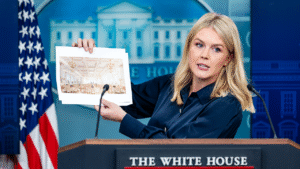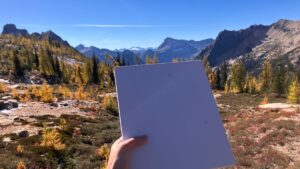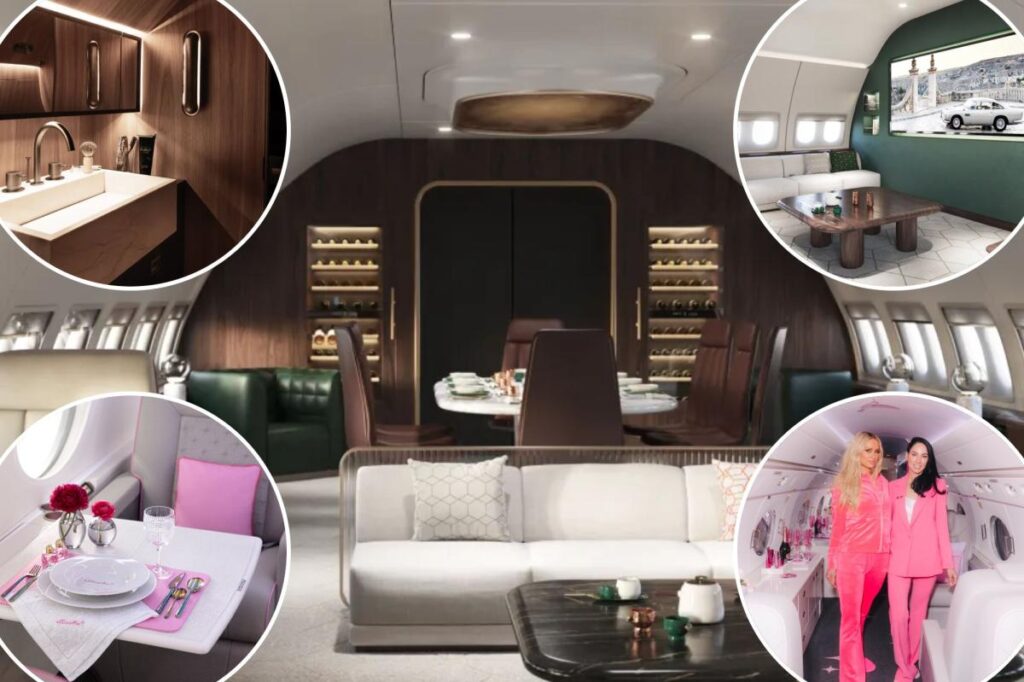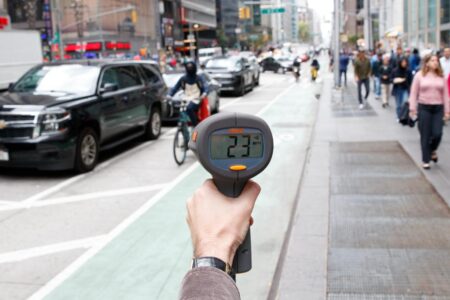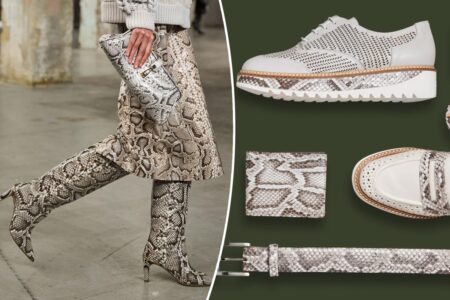Owning the planetŌĆÖs biggest superyacht is so pass├®.
Today, youŌĆÖre nothing unless you dump cash into a private plane or two ŌĆō┬Āor 38, as King Rama X of Thailand recently revealed.
And even then, youŌĆÖd better hire the very best interior designer to kit it out to your perfect spec.
Nearly anything goes, no matter how extravagant or bizarre the request ŌĆö and at whatever the cost.
Sarah Mespelt Larranaga, a specialist in private plane interior design, told The Post that ŌĆ£design and oversightŌĆØ can cost her clients between $150,000 and $200,000, depending on the length of the project.
But the real whopper, according to Larranaga, is the actual refurbishment, which on average can run an eye-watering $2 million to $5 million.
If you are spending big on your own jet ŌĆō┬Āthe popular Gulfstream G500 has a base price of around $45 million, for example ŌĆō why wouldnŌĆÖt you go the extra air mile and have it exactly as you want, with all the comforts of home, and then some?
ŌĆ£People love design and are traveling more since COVID, and so the market for private jets for Americans has increased,ŌĆØ Edward Yedid, partner at interior designers GRADE New York, told The Post.
ŌĆ£And if they have a designer for their houses, theyŌĆÖll likely want them to design the interiors of their plane, too,ŌĆØ Yedid continued, adding that they cannot disclose costs due to their clients.┬ĀŌĆ£ItŌĆÖs like an extension of the home.ŌĆØ
ŌĆśI have more clients than everŌĆÖ
Today, there are more than 15,000 private jets registered in the United States, and there was clear evidence of just how common they are now at SeptemberŌĆÖs Ryder Cup on Long Island, which saw over 3,000 private flights land in the greater New York area, several hundred of which popped into FarmingdaleŌĆÖs Republic Airport.┬Ā
This year alone, deliveries of new planes are projected to reach 820, up from 644 in 2020, while so-called ŌĆ£fractional ownershipŌĆØ ŌĆö in which customers own a share of a private jet ŌĆö is also increasing exponentially.
No surprise, then, that there is no shortage of creative designers clamoring for commissions, waiting to make your airborne dreams come true.
ŌĆ£I have more clients than ever at the moment,ŌĆØ said Larranaga, who is based in Los Angeles and Savannah, Georgia, and oversaw a year-long, $4 million makeover of ŌĆ£Sliv Air,ŌĆØ Paris HiltonŌĆÖs eye-popping, pink-splashed Gulfstream G450, which was delivered to her in June.
ŌĆ£IŌĆÖm currently working on a Falcon 7X,┬Āa Gulfstream D550,┬Āa Gulfstream D650┬Āand a Falcon 2000,ŌĆØ rattled off Larranaga, a design doyenne for nearly two decades with more than 100 projects under her seat belt.
ŌĆ£You can tell how popular private planes are becoming because it can be difficult to find available facilities that can actually work on them.ŌĆØ
Feng shui and falcons away
It seems that private jet owners, with their very deep pockets, will stop at nothing to get exactly what they want.┬Ā
In fact, the sky really is the limit.
In 2021, Long Island-based company International Jet Interiors paid homage Playboy founder Hugh HefnerŌĆÖs 1970s-era ŌĆ£Big BunnyŌĆØ jet in outfitting a new, $12 million Bombardier Global Express BD-700 for the iconic publisher, one complete with vibrant suede, crushed velvet, mohair sofas, and coverings of leather and herringbone for walls and floors, respectively ŌĆö plus a pop-up, well-stocked credenza-style bar, of course, and fine dining that would include a three-tiered seafood tower.
┬ĀŌĆ£It doesnŌĆÖt just take you somewhere ŌĆö being on the plane is a journey in and of itself,ŌĆØ a company rep previously told Architectural Digest.
And French design company Pinto, for instance,┬Āhas a long client list that includes the Royal Family of Saudi Arabia and their counterparts in Qatar. The firm had one super-wealthy Chinese client who insisted his jetŌĆÖs interior was designed in strict accordance with feng shui principles.
ItŌĆÖs a concept that Yedid of GRADE New York has noticed with their aviation clients as well.
ŌĆ£Something mentioned to us by a prospective client was that they wanted their plane designed very specifically to make them feel calm in the sky,ŌĆØ he explained to The Post, again declining to reveal costs.
ŌĆ£ThatŌĆÖs a pretty normal request.ŌĆØ
His design partner, Thomas Hickey, agrees.
ŌĆ£They want their airplanes to be an extension of their lifestyles, usually their homes, and prefer to travel in a familiar vibe.ŌĆØ
Even Princess BeatriceŌĆÖs husband, the Italian businessman Edoardo Mapelli Mozzi, is getting in on the act.┬Ā
Recently, his company, Banda, shared┬Āimages of its design for a Gulfstream 550, describing their first venture into private jet interiors as a nod to the ŌĆ£golden age of aviationŌĆØ with influences drawn from the 1950s and 1960s airliners.
For the most part, no client request is too ridiculous or extravagant.┬Ā
Hickey and Yedid, for instance, had one customer with a personal candy display unit that had to be refrigerated to a certain temperature to prevent his sweet treats from melting. ŌĆ£I wasnŌĆÖt too bashful about having some for myself,ŌĆØ joked Hickey.
Patrick Knowles, whose titular design company creates interiors for both planes and superyachts, told The Post that he once designed a plane for an unidentified royal client whose favorite sport was falconry, installing a bespoke seating compartment for a team of four handlers, with each seat featuring a custom-made arm support so they could sit in comfort with their birds.
ŌĆ£It was an interesting assignment, to say the least,ŌĆØ said Knowles, based in Fort Lauderdale, Florida.
While he couldnŌĆÖt share photos and other retooling specifics, he estimated that ŌĆ£everything associated with creating the falcon cabin ŌĆ” would probably cost in the area of half a million in todayŌĆÖs dollars,ŌĆØ he said.
Even if you arenŌĆÖt trying to get birds to soar higher than their wings will let them, youŌĆÖd better have deep pockets.
ŌĆ£As aircraft size, volume and scope have a very wide spread, design fees can range from a low of around $250,000 up to north of a million, plus the cost of materials,ŌĆØ Knowles said.
ŌĆśNever enough spaceŌĆÖ
Of course, some requests arenŌĆÖt possible ŌĆō at least not yet.
While some designers ŌĆö like French company Billards Toulet and NorwayŌĆÖs Stable ŌĆö have been able to install full-sized pool tables on superyachts,┬Āmounted on a gyroscopic suspension system to keep them level, they havenŌĆÖt quite mastered how to do it at 35,000 feet.
Knowles said that, over the years, he has fielded numerous ŌĆ£ostentatiousŌĆØ appeals from deep-pocketed jetsetters, ŌĆ£including the likes of swimming pools. WeŌĆÖve heard it all.ŌĆØ
He noted that those with ŌĆ£great scales of wealthŌĆØ who could ŌĆ£afford virtually anythingŌĆØ can have downright unrealistic dreams due to ignorance about limitations.
ŌĆ£Such requests often fell under the assumption that if one has the money to afford anything, they could indeed have anything they wanted,ŌĆØ he said.
Then there are the more dangerous demands.
ŌĆ£Well, it transpires gun┬Āranges and aircraft cabins really do not go together, regardless of how large your aircraft is,ŌĆØ Knowles said with a laugh about an actual request.
ŌĆ£Many requests turn out to be nothing more than curiosity,ŌĆØ he continued. ŌĆ£In this project, the ownerŌĆÖs rep mentioned that the owner loves target shooting and asked, ŌĆśIs there any way that something like that could be accommodated?
ŌĆ£The answer was a flat-out NO.ŌĆØ┬Ā
But while virtually anything is feasible in terms of aesthetics, all interior designers face the same issues when working on private planes, particularly when it comes to finding enough storage space.┬Ā
Bedding, towels, luggage, food, furniture and safety equipment ŌĆö plus a luxury like, say, a fitness freakŌĆÖs treadmill ŌĆö all need to be stowed somewhere.┬Ā
However, planes arenŌĆÖt built for packing like a hoarderŌĆÖs storage unit.
ŌĆ£Capitalizing on every conceivable space within a cabin can be frustrating at best, and many times exhausting,ŌĆØ said Knowles.┬Ā
Thomas Hickey agrees.┬ĀŌĆ£We are limited to space, so every inch counts, and we then have to micro-design the details: for storage, for accessibility, and for retrofitting any technical and technological upgrades,ŌĆØ he said.
Designers especially have to worry about the weight of any fixtures and fittings their clients desire, as heavy furniture or accessories ŌĆö such as water tanks for bespoke showers ŌĆö can dramatically reduce the fuel efficiency of the aircraft.
ŌĆ£You have to be really careful because the last thing you want is for the direct flights your client needs to make suddenly becoming impossible just because of what is inside it,ŌĆØ said┬ĀLarranaga.
ŌĆ£ThereŌĆÖll never be enough space on a private jet,ŌĆØ he lamented.
All renovations ultimately have to be signed off by the Federal Aviation Administration (FAA), too;┬Āeven the fabrics and carpets must be fire-rated and pass FAA guidelines.
No matter whatŌĆÖs done, the whole process can be a time-suck.
A light interior refresh might take only one to two weeks, but a full redesign can last three to six months, including FAA review and approval, and a job with major structural avionic modifications can take six months to a full year.
Plus, ongoing maintenance can run the same as it would for a house on terra firma, but the difference is that most private jet owners will have the big bucks to pay people to do it all for them.┬Ā
However, for an endeavor so wallet-busting, the shelf life of a private jet is much shorter than the 12.6 years, on average, that Americans keep a car.
ŌĆ£Some clients might change their aircraft interior every five years or so,ŌĆØ according to Larranaga.┬Ā
Or they nonchalantly discard them as simply as one might flip a well-worn leather sofa, a particleboard dresser, or a used Honda on Facebook Marketplace.
ŌĆ£Many just sell it to someone else and get a new one,ŌĆØ Larranaga said.
Read the full article here


